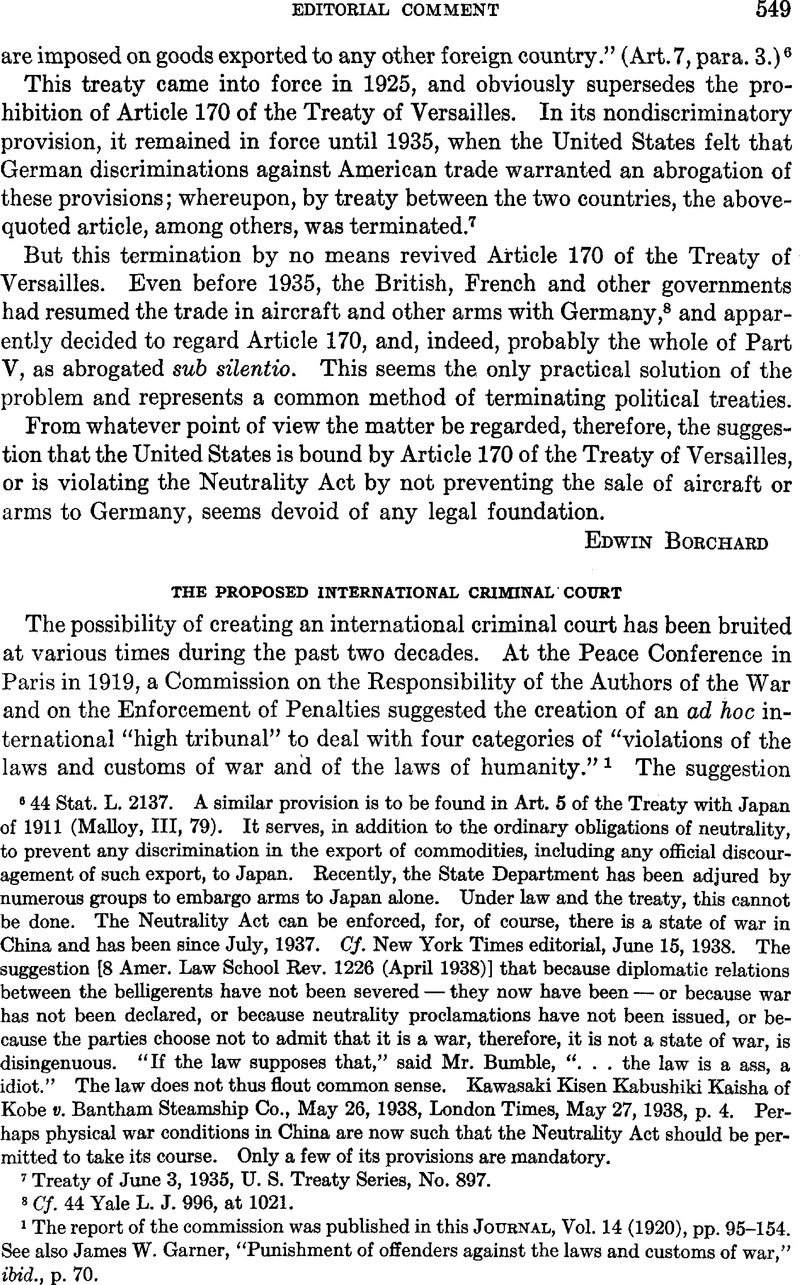Published online by Cambridge University Press: 12 April 2017

1 The report of the commission was published in this Journal, Vol. 14 (1920), pp. 95–154. See also Garner, James W., “Punishment of offenders against the laws and customs of war,” ibid., p. 70.Google Scholar
2 Proceedings of the Committee of Jurists, 1920, p. 748.
3 In 1921, following an address before the American Society of International Law by Professor Jesse Reeves on “International Criminal Jurisdiction,” Mr. Elihu Root, who had served as a member of the 1920 Committee of Jurists, is reported to have said: “With reference to the action of the Hague Committee of Jurists regarding the International Court of Justice, I would like to state that the committee did not recommend it. The project was submitted to the committee, and, I think, the last day of the session, or the day before, it was brought up by the president, Baron Descamps, of Belgium, but the committee did not consider it or discuss it. They referred it to the Council for consideration without any action on the part of the committee. I doubt if there would have been a single vote in the committee except that of the author of the project in its favor.” Proceedings of the American Society of International Law, 1921, p. 69.
4 Procès-verbal of the 10th Session of the Council, 1920, pp. 181–2.
5 Records of the First Assembly, Committees, p. 589.
6 International Law Association, Report of the 31st Conference, 1922, p. 86.
7 Id., Report of the 33d Conference, 1924, pp. 74–111.
8 Id., Report of the 34th Conference, 1926, p. 183. The proposed “Statute of the Court” adopted by the conference is on pp. 130–142.
9 Union Interparliamentaire, Compte rendu de la XXIIIe Conférence, 1925, pp. 46–50, 475, 801.
10 Actes du Congrès International de Droit Pénal, 1926, p. 634.
See also a report by a subcommittee, in Proceedings of the American Society of International Law, 1922, pp. 69–71.
11 Without attempting an exhaustive bibliography, mention may be made of the following: Bellot, H. H. L., “La Cour permanente internationale criminelle,” 3 Revue internationale de droit pénal (1926), pp. 333–337 Google Scholar; Brierly, J. L., “Do We Need an International Criminal Court?” 8 British Year Book of International Law (1927), pp. 81–88 Google Scholar; Caloyanni, M. A., “The Permanent International Court of Criminal Justice,” 2 Revue internationale de droit pénal (1925), pp. 326–354 Google Scholar, 3 id. (1926), pp. 492–515; Caloyanni, , “La Cour criminelle internar tionale,” 5 id. (1928), pp. 261–264 Google Scholar; de Vabres, Donnedieu, “La Cour permanente de Justice internationale et sa vocation en matière criminelle,” 1 id. (1924), pp. 175–201 Google Scholar; A. Lé vitt, “A Proposed Code of International Criminal Law,” 6 id. (1929), pp. 18–32; V. Pella, La criminalité colledive des États et le droit pénal de l’avenir (2d ed., Bucarest, 1926), 360 pp.; Pella, “Rapport sur un projet de statut d’une Cour criminelle internationale presenté au Conseil de diredion de l’Association internationale de droit pénal,” 5 Revue internationale de droit pénal (1928), pp. 265–292; Phillimore, “An International Criminal Court and the Resolutions of the Committee of Jurists,” 3 British Year Book of International Law (1922–23), pp. 79–86; J. A. Roux, “A propos d’une Cour de cassation internationale,” 6 Revue internationale de droit pénal (1929), pp. 12–17; Roux, “L’entr’aide des états dans la lutte contre la criminalité,” Académie de droit international, 36 Recueil des Cours (1931), pp. 77–181; Q. Saldafia, “La justice pénale internationale,” 10 id. (1925), pp. 223–429; E. Vadasz, “Juridiction criminelle. internationale,” 5 Revue de droit international, de sciences diplomatiques et politiques (1927), pp. 274–279; von Weber, H., Internationale Strafgerichtsbarkeit (Berlin: Dümmler, 1934), 176 pp.Google Scholar
12 Extradition of certain persons accused of this crime was refused by Italy on the ground that the crime was political, but they were convicted par contumace in France. See Hudson, , Cases on International Law (2d ed., 1936), p. 946 nGoogle Scholar.
13 League of Nations Official Journal, 1934, pp. 1731, 1839.
14 Idem, p. 1760.
15 The Final Act of the Conference was published in League of Nations Document, C.548. M.385.1937.V. All of the members of the League of Nations and ten states not members were invited to be represented at the conference.
16 Idem, C.546.M.383.1937.V.
17 Idem, C.547.M.384.1937.V. The signatories were Belgium, Bulgaria, Czechoslovakia, France, Greece, Netherlands, Rumania, Spain, Turkey and Yugoslavia.
18 See the Treaty on Extradition and Protection against Anarchism, signed at Mexico City, Jan. 28,1902. 6 Martens, Nouveau recueil général (3d sér.), p. 185.
19 Hudson’s Cases on International Law (2d ed., 1936), p. 946 n.; Research in International Law, Extradition, in this Journal, Vol. 29, Supp. (1935), pp. 114–115.
20 See Hudson, , “The Central American Court of Justice,” this Journal, Vol. 26 (1932), p. 759.Google Scholar